 |
: May 2004 |
||||||||
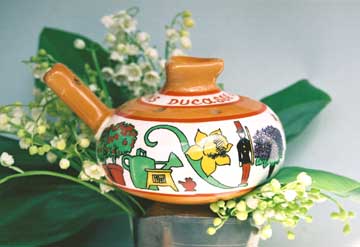 |
To the Belgian friends of this website. Thank you for their assistance and their support. A special thank to Olivier Dinant for his great information. |
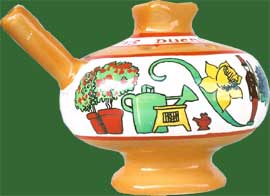 |
|||||||
| Discovery context:
A collector of antique musical instruments found this whistle in Belgium some years ago. General description: The whistle is in the shape of a "watering can ". It has a globular body on a socle with a triangular button at its top. The whistle is inserted into the body. Five holes are bored on the top of the body. The decoration: It is an orange ceramic whistle with two white stripes bordered of red feature. The higher white stripe carries the inscription: "Ducasse de Messine MONS". The central stripe is decorated with varied elements : flowers and toys, even a little clay whistle.
|
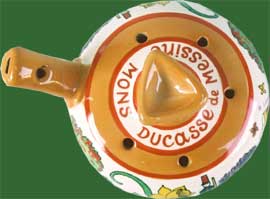 |
||||||||
 |
|||||||||
| Study of the object: Typology: It is a water whistle, a warbler. The holes on the top are to fill it. The inscriptions on the whistle give many information about the manufacture and when was used this whistle. Under the whistle is marked the year "1939" and the name of the manufacture "BOCH Frères". The signature "H Léonard" is in the decorated stripe near a lampion. The manufacturer: The BOCH family began to produce pottery in Luxembourg in 1767. After the separation of Belgium from Luxembourg in 1839, the family settled in Belgium and in 1841, founded the Kéramis company in a hamlet 15 kms from the town of Mons. With the development of the company, a city borned and was named the "Louvière" (the place of the she-wolf), the she-wolf being the symbol of Boch Kéramis. |
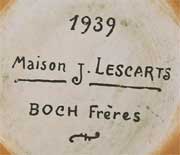 trademark BOCH Frères |
||||||||
 Mark 1938 H.Léonard Boch brothers House Jean Lescart
| Henri Léonard is a Walloon draughtsman who illustrated in years 1920-1930 several books on the folklore of Mons. He made another creation for the Kéramis company: a plate of 1938 "the combat of Lumeçon".
The house Jean Lescarts (maison J Lescarts) is the last thing to explain in the mark of the whistle. It has nothing to do with the manufacturer as one could think. This house is well known in the town of Mons. It was the infirmary of an old convent built in 1636. It has been since 1931 the headquarters of the Jean Lescarts Association, an association created to collect in this house work of art and documents interesting the folklore of the Mons area. This whistle and the plate of 1938 were thus made for this association and undoubtedly sold to finance it. Both were made for the main festival of Mons: the "Ducasse" of Mons. |
||||||||
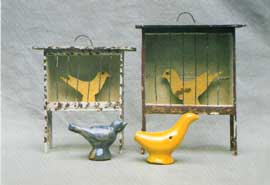 post card "Musée du Folkore et de la vie Montoise" "GAYOLLES" ET SIFFLETS DE MESSINES MONS Ville de Mons et communauté française
| The Ducasse of Messine and its mascots:
The word of "Ducasse" exists in Belgium and in the north of France. It comes from the festival of the "dedication", i.e. the commemoration of the dedication of a church to its Patron saint. With the centuries, this festival of the parish became simply the "ducasse". In Mons, the "ducasse of Messine" takes place on the third weekend in March. It recalls a pilgrimage to "Our Lady of Messines" in the parish of Saint Nicolas in the suburb of Bertaimont. The worship was for a picture of Our Lady brought from the town of Messines-lez-Ypres. This pilgrimage has been quoted since 1620 in the archives but the feast probably settled in its present organisation in the 19th century. Important crowds came there from Belgium or France.
|
||||||||
| As for all feasts and important meetings, many sellers of penny toys for children were there for this pilgrimage. Some of their items became symbols of the Messine. Formerly, those toys were made by the inhabitants during the winter time. Selling them during the Ducasse, theirs makers earned a small income. Those whistles are the one represented around the whistle of the month.
|
|||||||||
|
The mill : structure made with wicker and bamboo covered with colored paper, with small blades (formerly made with playing cards) turning with the wind. | ||||||||
|
The "gayole" : small wooden birdcage with a stylized bird inside. This object recalls the chaffinch cages formerly hanging on the front of the houses. | ||||||||
|
The "WaWa" : a small cylindrical cardboard box closed with only a close side, covered with painted paper and linked to a stick with a piece of string. By turning the box around the stick, one produces a sound like dog barking. | ||||||||
|
The "Sôdart" : small wooden handcrafted soldier, dressed in the different uniforms of the regiments barracking in Mons. | ||||||||
|
The "nightingale" : the water whistle presented here. | ||||||||
| the flowers: |
|
Other merchants were selling violets et daffodils picked up in this suburb of Bertaimont then rural. The pilgrims bought those bunches to offer to Mary. |
|
||||||
| watering cans : | As the tin-smiths and the zinc workers were unable to work during winter, they made small buckets and watering cans. They sold them to the pilgrims to provide for their family. |
|
|||||||
| Many other traditions are related to this Ducasse. They are still living and changing. Nowadays, this floral and musical tradition takes place during a week. A visit to the site of the town of Mons can give you information of the Biloute's adventures and his Giants's family. This rich web site was a source for this page. | |||||||||
Postcard. 1904 Detail |
The Ducasse of Mons. Mons is famous for another Ducasse which takes place each year on the Trinity Sunday. The procession of Saint Waudru (patron of the town) and the fight of Lumeçon are the main events. For this feast, a huge crowd is gathering to participate in this event and, even if the clay whistles are not honoured during this time, the feats is going full swing in the streets. Such traditions came from the Middle-Age and you must visit the wonderful web site of the ducasse . After visiting this site, you will go to Mons do find again the spirit of the feast that the Belgians have still preserved since the Middle-Age. |
||||||||
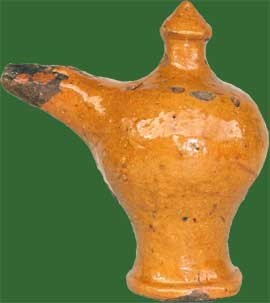 Water whistle Earthenware Private Col. |
The antique models:
Did the members of association J Lescarts decided in 1939 to produce whistles in order to revive an old tradition? Only the oldest men in Mons could answer. The whistle fits perfectly in the continuity of the models manufactured in the beginning of the 20th century. The museum of the folklore and the life Montoise shows a similar whistle of 1939 and two older earthenware whistles. Undoubtedly these two whistles were used as models for the whistle of 1939. Other models are known in the region. The number of filling holes can vary as well as the shape of the button. These whistles are the heirs of the whistles in the shape of owl known in the Former Low Countries since the end of the Middle Ages. Any information about their center of production will be welcome. | 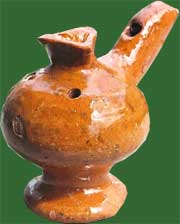
Water whistles Private col.
|
|||||||
| This "whistle of May" is related with a still living festival. Maybe the visitors of the site will be numerous to go to the festival of the Ducasse of Messine and/or the Ducasse of Mons.
It is during such festivals when the clay whistles find again their function.
| |||||||||